P-61B Black Widow “The Lady in the Dark”, 1/72 Dragon
opps, my lunch break is almost finished..! I'll describe shortly
1/72 P-61B from Dragon model.
Ivory color oil washing, Finished with acrylic gloss paint tapped/ brushed irregularly for adding realistic reflection. all technic is same as I used on recent Helldiver build.
Oh, for this tiresome birdcage painting I roughly brush-painted with Tamiya's acrylic black and just scratched all the rest with wooden toothpick. I think this is easiest way avoiding masking hell.





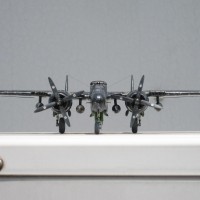
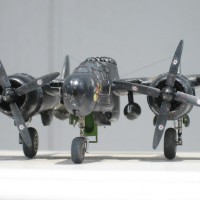


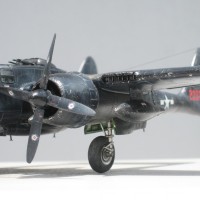







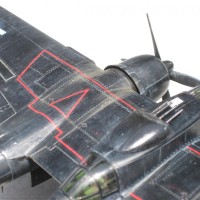


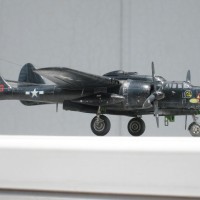





Nice work on this.
For those who don't know the story of "Lady In The Dark":
One of the more interesting stories about the P-61 involves the P-61B “Lady in the Dark,” operated by the 548th NFS from Iwo Jima from April 1945 to the end of the war. On the night of August 14, 1945, “Lady in the Dark” was flown by a different crew from that regularly assigned. Vectored onto a bogie inbound at low altitude, the Widow scored a victory when the Japanese fighter hit the water and exploded without a single round being fired. Officially, the war in the Pacific ended at midnight, but the possibility of night kamikaze attacks against American airfields remained and the P‑61s were kept on alert.
On the first night of “peace” in the Pacific since Pearl Harbor, Captain Lee Kendall took off at 1910 for a routine patrol. 45 minutes later, Iwo Jima ground control reported a bogey approaching the P‑61 at an altitude of 4,500 feet. Contact was quickly established, with Kendall's radar observer picking up “window” several times, meaning the intruder was using defensive tactics as he got closer to Iwo Jima. As “Lady in the Dark” closed, the intruder demonstrated awareness of the presence of the night fighter by making hard turns in an effort to shake any pursuit.
As Kendall recalled years later to an interviewer: "Getting close enough for a positive identification proved to be difficult. He was taking violent evasive action and dropping window, which was bundles of tinsel‑like strips of aluminum foil designed to confuse our radar. This guy knew we were behind him but I have no idea how he knew. My R/O, Lieutenant Scheerer, was talking me in closer to about 800 feet when all of a sudden the left side pilot's window popped open and the rush of air drowned out the communications with him. Down this low at such a high speed and not being able to understand my observer was very unhealthy.”
"I had to back off, secure the window and then get back in touch with him. In the meantime, I lost contact with the bogey, but quickly picked him up again and was able to close on his tail again despite his defensive moves. I had one eye on my target and one eye on my altimeter. Suddenly, the window popped open again and once again I closed it, and as I picked him up for a third time the same thing happened again! Regardless, I went after him for a fourth time and control gave me permission to shoot him down even though we didn't have a positive identification."
Kendall’s R/O locked on, but a few seconds later the bogey completely disappeared off the scope and no more window was detected. According to witnesses on the ground, the intruder, a Nakajima Ki.44 “Tojo”, crashed and the debris was scattered over a wide area. This was not listed as an official victory since the war was officially over, but the fact remains that “Lady in the Dark” scored the final two aerial victories of World War II without firing its guns.
Wow.
Thanks a lot Tom. I just wonder about this story too. that is not well presented in here S.Korea. you completed this article
Hongseob CHOI, your model is excellent. It looks bigger than 1/72nd scale due to your great finishing and weathering. Well done, my friend!
Tom, this "slice" of history is once again very interesting. Thanks for sharing the facts.
Thank you Jeff. I mentioned to make all weathering in smallest particle to have a look in appropriate scale.
The "birdcage" turned out exceptionally well (especially with a toothpick in 72nd scale) - the best way to avoid 'masking hell' is a canopy mask set - if you can find 'em - but it doesn't look like you needed it anyway. great overall work, sir.
I really hope those all kit makers puts slice of mask set stickers in box and increase all kit's price by several dollor... until that day we all modelers become a inventors day by day.
Beautiful model! I know some purists lament the use of light washes on dark schemes, but I love the way it highlights details that would otherwise complete disappear. The paint and weathering work is fantastic, and I'm with you - I paint most canopies the same way (all I build is 1/72, so some of those complex canopies would be a nightmare to mask!).
Hooray! It's so good to find a 1/72 workmate. Now I hope 3d printing technology save us by making birdcage frame separately by clear part 🙂
Nice job. I too use the toothpick tech.
Now I'm without fear having colleagues!
First, let me say you are an incredibly talented builder. As stated above, I really can't believe you achieve this detail and realism in 1:72 scale. You are a true artist.
Second, I'd enjoy a bit more explanation on your canopy technique. Sounds great and would like to understand the method.
Keep building, you are a true craftsman.
You're too generous! Thank you for your compliment Matt. I'll do my best for future build!
Toothpick technic is nothing more, brush acrylic paint (I used Tamiya's one) and scratch with toothpick where sticks out of designated area
Another fantastic build! Ah toothpicks you say.
It not result cleanest but for having less stress!
Looks really great. Black is tough to get it to look realistic but you captured the look with all the different techniques u used. Really nice looking and weathered well. Does not look small as 1/72..I would of guessed bigger scale. Love the toothpick method for canopies. That saves the day for me all the time when doing intricate canopies. WOrks great if you use acrylics.
Excellent, sir!
Gabor! Thanks my friend
Hongseob, as others have said, a very attractive model. It’s good to see someone attempt several different techniques on one project.
My personal preference, however, is that the technique(s) should not overwhelm the subject, and I think in a couple of areas, for me, you’re drifting just over that line.
This is not to detract from the overall confidence you’ve displayed in the project as presented. It’s a good subject study in a difficult scale.
Thank you for appropriate critic Rob! Actually I was too excited applying new techniques. I hope to arrange it well in my following build!